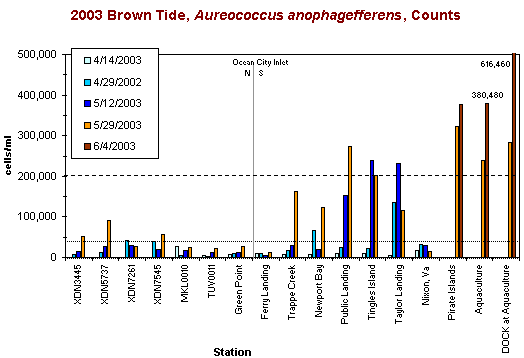|
June 11, 2003
Brown Tide Blooming in MD Coastal Bays. |
|
The algae responsible for Brown Tide, Aureococcus anophagefferens has been identified in all of the Coastal Bays between May 14th and June 4th. Routine monitoring samples have been collected by the Maryland Department of Natural Resources and analyzed by the Academy of Natural Sciences Estuarine Research Center. For the northern bays, Isle of Wight and Assawoman Bays have exhibited Category 1 blooms while the lower St. Martin River had Category 2 blooms. In the southern bays, Category 2 blooms have been present in Newport Bay. Chincoteague Bay has been experiencing a large scale Category 3 bloom from Tingles Island (peak concentration = 238,808 cells/ml) in the north to Pirate Islands (peak concentration = 376,329 cells/ml) in the south and stretching across the bay to include the water from Public Landing (peak concentration = 616,460 cells/ml) to Taylor Landing (peak concentration = 232,021 cells/ml).
Category 3 blooms can have
significant impacts to the health of shellfish and bay grasses. MD Department
of Natural Resources will continue to monitor the bloom until water temperatures
exceed conditions preferred by Aureococcus and the bloom declines,
typically in early July. |

